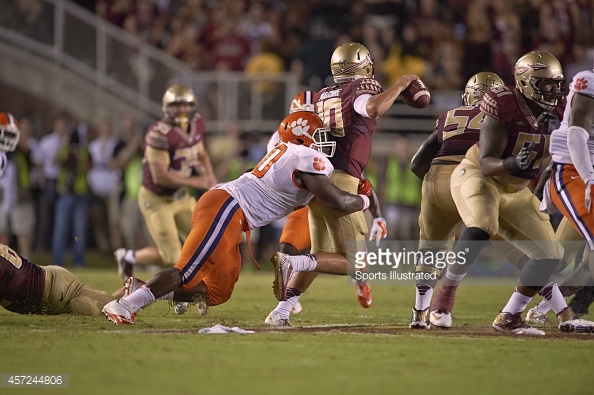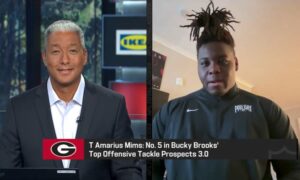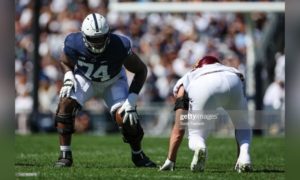Continuing our new article series every Saturday morning for the rest of the season, I take a look at three draft-eligible college football prospects the Pittsburgh Steelers could and should examine at length this spring. Obviously a lot will change between then and now, so this analysis is based on where the current roster stands, with the occasional peak at where they might be after this upcoming offseason.
Not every player listed here is necessarily a great fit in Pittsburgh, but they are simply three prospects I’ve decided to look at that week in my scouting. If you have any suggestions or a desire to see a specific player covered, please feel free to let me know in the comments section below.
Player: Shaq Lawson
School: Clemson
Position: EDGE
Class: RS Junior
Height: 6’3
Weight: 275
Analysis: Not to be confused with Auburn edge rusher Carl Lawson, Shaq is a thickly built edge defender who admittedly probably projects best to a 4-3 alignment, although he played from a two and three point stance at Clemson. Lawson isn’t the greatest athlete at the position, but he does bring some wonderful traits to the table, mainly power and violent hand usage.
Lawson’s well-muscled frame is NFL-ready even as a redshirt junior, with the powerful build to withstand a beating and take on blockers consistently with good results. He’s very physical and aware as a run defender, as Lawson will see trap blocks coming and take them on aggressively. The defensive end’s ability to recognize plays quickly and rarely be fooled by misdirections belies a strong knowledge of his opponent and their tendencies. Lawson also may be the best edge setter in college football, almost never moved off the ball and consistently using his arm extension to control blockers and re-route ball carriers inside.
Where Lawson struggles is in space, as he simply doesn’t have the fluidity and quickness to be able to mirror more elusive players’ movements. Clemson only occasionally dropped him into coverage, and Lawson showed great urgency and physicality against receivers down the field, but it won’t be a primary role for him in the NFL obviously.
The biggest plus with Lawson is that he is almost always the attacker, choosing to be proactive rather than reactive as a pass rusher and a run defender. There’s a fine line between playing that way and being overly aggressive or undisciplined, a line which Lawson rides extremely consistently. He’s rarely out of position as a run defender, and does a great job of stacking and shedding blocks to create disruption in opposing teams’ backfields.
As a pass rusher, Lawson does not have great bend or flexibility to win the edge consistently. He’ll flash a nice rip move, and is tough to run off the corner because of how stout he is, but you don’t see a guy with that elite athleticism to flatten quickly to the quarterback. Where Lawson wins is as a speed-to-power rusher with emphasis on the latter portion. He and Notre Dame left tackle Ronnie Stanley had some awesome battles when their two teams met, but Lawson was consistently able to leverage and get a great push on Stanley in pass rush situations. The big tackle often re-set and held Lawson off, but it was great to see the edge rusher get a strong push against one of the more powerful offensive linemen in college football. Lawson makes it very difficult for blocker’s to land punches on him cleanly because his hands and upper half are so active and violent. He can get off-balance doing this, but one of Lawson’s go-to moves is to overhead press a tackle’s hands into the air and work into the blocker’s frame so that the Clemson junior is the one in control. Results in some fun, combative battles, but it does typically take longer for Lawson to get home on the quarterback then it would for your average speed rusher.
Last three things to note. First, Lawson is too consistently the last defender out of his stance, and doesn’t have the most explosive get-off. If he did, his bull rushes would be even more effective, but Lawson is still very raw off the line of scrimmage. Will need plenty of work on getting out of his stance with immediate energy in order to put offensive tackles under duress.
Second, Lawson has one of the nastiest spin moves I’ve seen from a college player. No wasted movement, very smooth, and knows when and how to use it. Huge weapon for him, because he’ll feign bending the edge, which isn’t his strong suit, only to counter back inside with the spin when the tackle oversets. Got Stanley with it so baldy, the offensive tackle had to reach out and simply tackle him around the waist in order to prevent a sack. I mean it is a thing of beauty.
Third, Lawson certainly is not in bad shape, but he needs to get in better shape for the NFL. His frame could be toned up some, and he’s clearly gassed on a number of reps on tape. He plays very hard and physical when he isn’t tired, but there is a clear drop-off when he begins to run out of energy. Getting in tip-top football shape will hopefully be a focus for him this offseason as he trains for the combine and his pro day, should he declare that is.
Lawson likely isn’t a fit for Pittsburgh, but he’s been requested by several of you, and we’ll eventually look at every player anyway, so here you are. I love Lawson’s style meshing with a Pittsburgh brand of football, but the reality is that he is not a good enough athlete in space to play as a 3-4 outside linebacker as exclusively as Pittsburgh would ask him to, and his frame is too maxed out to consider a move to five technique. I think he’s a 4-3 defensive end who will be a game-changer against the run from day one, but will need to seriously work on his get-off and explosive traits in order to become a great pass rusher.
Player: Jayron Kearse
School: Clemson
Position: S
Class: Junior
Height: 6’5
Weight: 220
Analysis: I’m not a huge fan of comparing college players to NFL players, because I feel like we reach too often in order to make the match fit, but I’d be lying if I said Kearse doesn’t remind me a good bit of George Iloka in Cincinnati. I know, that is a really lazy comparison on the surface, because both are inordinately tall and lanky for the position, but even their abilities and playing styles are similar to me.
Iloka is more technically sound than Kearse at this point, as the Clemson safety shows an upright backpedal and inconsistent run fills as a junior. Like Iloka, Kearse is much more physical than his slender frame would suggest, taking on ball carriers and even blockers with ferocity. He’ll bring it as a tackler if he lines you up, but generally shows strong form to make stops consistently.
The big question mark with Kearse, to me anyway, is his athleticism. I don’t think he’s exceptionally fast, as a long strider who covers a lot of ground quickly, but doesn’t have blazing closing speed. His lateral movements worry me a bit, as does his stiff hips when he has to open up and run. Again, some of that may be technique issues, because he is too high in his pedal, or he may just not be that fluid. Clemson asked him to blitz off the edge a lot where his length and strength could be utilized, but Kearse’s lack of hip/ankle flexibility kept him from getting home too often. I’m looking forward to seeing his testing numbers, but right now I’m under the impression that Iloka is just an average athlete for his position.
That’s ok, especially seeing as how his strides and overall length for the position help make up for it somewhat. Kearse is physical down the field and at the line of scrimmage with receivers during the occasions he’s asked to step into the slot. He battles hard for leverage and makes receivers uncomfortable, but is just too stiff and slow to ever make the move to corner full time.
Iloka wasn’t a great athlete either, but he’s found a great home in Cincinnati and has the range, smarts and physicality to play a big role there. Kearse can do the same, but I think it is going to take some time. Unfortunately without All-22 tape, instincts in coverage and route-recognition, two skills that will be essential for Kearse to thrive in the NFL, are very difficult to evaluate. Hopefully I’ll obtain some more/better tape on Kearse soon, but in the three games from this season that I watched, he was rarely challenged down the field.
Kearse will occasionally step into the box, but that really isn’t his role at the next level. He can do it when absolutely necessary, and uses his length well to keep blockers from overwhelming him, but he’s much better suited for work on the back end. Right now I just think he’s going to have to post better athletic testing numbers that I expect for Pittsburgh to be interested in him.
Player: Mackensie Alexander
School: Clemson
Position: Cornerback
Class: RS Sophomore
Height: 5’11
Weight: 195
Analysis: Completing a trio of Clemson players, Alexander might be the best cornerback in the nation you haven’t heard that much about. This class is stacked with quality corners, but I’m a huge fan of Alexander and here’s why I think Pittsburgh may be too.
The Clemson corner is young, but doesn’t play that way at all. His route-recognition isn’t always right, but he can typically diagnose how an offense is trying to attack and beat them to the punch. Blew up wide receiver screens on tape, more than likely because he’d studied his opponent and knew what to expect.
Alexander is a fantastic athlete with some of the smoothest hips and feet that I’ve seen for a cornerback. He plays with great urgency and has the short area quickness to mirror-and-match shiftier receivers, and recover if he makes a false step. Kermit Whitfield has blazing speed for Florida State, and Alexander matched him stride for stride down the field. Ditto for Notre Dame’s Corey Fuller. His 40 might not be 4.3-esque, but I have no qualms about his long speed to stick with receivers vertically.
Alexander is not only an excellent athlete with great closing speed on the ball and top-notch footwork, but he is also exceptionally physical and plays with a chip on his shoulder. The corner will re-route receivers off the line of scrimmage with good press technique, and won’t hesitate to handfight down the field. He’s also a very good tackler who is active in run support and won’t surrender outside leverage, consistently spilling the ball back inside to his help.
There aren’t many weaknesses to Alexander’s game, but I did notice two things I want to see improve. First, the corner will occasionally open his hips the wrong way, jumping the gun a bit and allowing the opposing receiver to gain an undesirable amount of separation. Needs to read the footwork and wait a tad longer to diagnose and close on the route.
Second, I want to see Alexander find the football in the air with greater consistency. He’s got the athleticism and speed to stick with receivers, yet still be able to find the football. It isn’t a huge problem area yet, but I think there are ball skills that Alexander hasn’t had the chance to really show off yet.
Alexander’s ability to play in any coverage scheme, combined with his high-energy playing style and excellent work in run support make him a definite option for Pittsburgh in the 2016 draft. Right now I have a hard time seeing the Clemson corner fall out of the first round, and I think he’ll test great at the combine. The Steelers obviously have a lot of decisions to make this offseason pertaining to the corners presently on their roster, but Alexander’s incredibly well-developed skill set will be tough to pass on regardless of the situation in Pittsburgh. At 22 years old, I would be surprised if Alexander decided not to declare for this year’s draft, especially with his stock so high already.
If you enjoyed this article, please check out the other volumes of the series:
Steelers Draft Watch List Series: Volume 1
Steelers Draft Watch List Series: Volume 2
Steelers Draft Watch List Series: Volume 3
Steelers Draft Watch List Series: Volume 4
Steelers Draft Watch List Series: Volume 5








